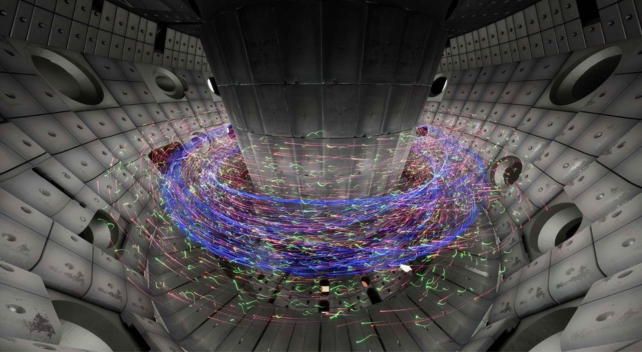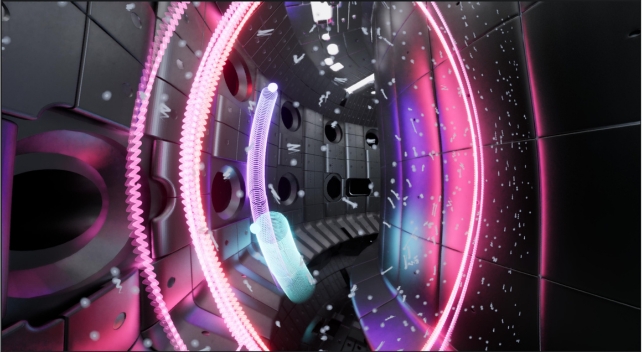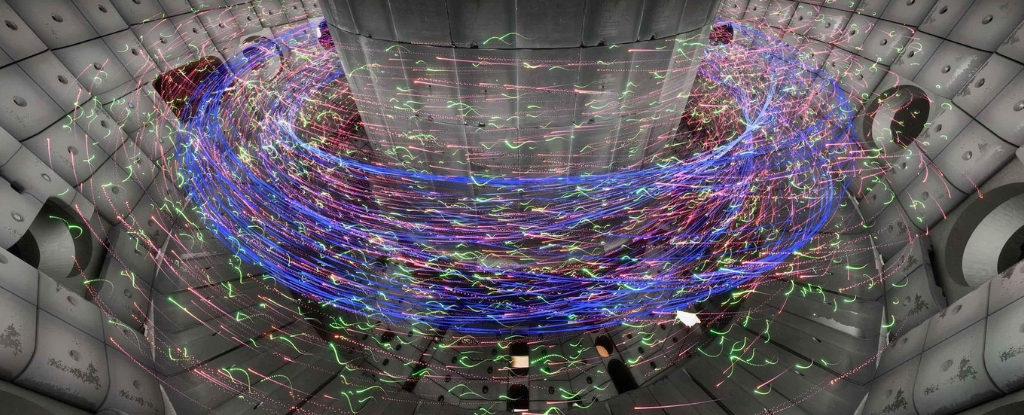In terms of promising forms of energy, Nuclear fusion It checks all the boxes: clean, abundant, continuous and safe.
It is produced when the lighter nuclei of two atoms fuse to form a heavier nucleus, releasing a large amount of energy in the process.
To create a controlled fusion reaction, a giant ring-shaped reactor is needed, packed with magnets to create a magnetic field that makes atomic particles fly around and dance like a swarm of bees.
Hard to imagine? Luckily, thanks to amazingly realistic 3D visualization technology, you can now see a live simulation of this type of reactor, called a tokamak.
At EPFL, Institute of Experimental Museology (EM+) specializes in this technology and has developed a program to convert terabytes of data generated from tokamak simulations and tests carried out by EPFL’s Swiss Plasma Center (SPC) into an immersive 3D visualization experience.
For ordinary people, this visualization is a journey through a circle of fireworks that show the possible energy sources of the future. For scientists, it is a valuable tool that tangibly represents the complex phenomena of quantum physics and helps to understand the results of their calculations.
Extremely detailed images show wear and damage
A four-metre-tall, ten-metre-diameter panorama, the 3D visualization is a faithful recreation of the interior of EPFL’s Variable Configuration Tokamak (TCV), rendered in incredible detail that rivals even the highest quality gaming experiences.
This experimental reactor was built over 30 years ago and remains the only one of its kind in the world.
“We used a robot to generate ultra-high-resolution scans of the inside of the reactor, which we then compiled into a 3D model that recreated the reactor’s components down to their textures,” says Sammy Mannen, a computer scientist at EM+.
“We were also able to capture wear and damage to the graphite tiles that line the reactor walls, which are exposed to extremely high temperatures during TCV test runs.”
SPC engineers provided equations to calculate exactly how quantum particles move at any given time. EM+ researchers then incorporated these equations, along with reactor data, into a 3D visualization system. The catch: all the calculations had to be done in real time.
“To create just one image, the system needs to calculate the trajectories of thousands of moving particles 60 times per second for each eye,” Mannen says.
The massive computations are carried out by five computers, each with two GPUs, that EM+ purchased for the project. The computer output is sent to the panorama’s five 4K projectors.
“Advances in infographics technology have allowed us to build a system,” says Professor Sarah Kenderdine, director of EM+, “that would not have been possible even five years ago.”

The result is stunningly realistic images: you can see the injectors that pump particles into the Tokamak, and the graphite tiles that can withstand temperatures of over 100 million degrees.
And the scale is impressive: To give the viewer an idea, the visualization includes an image of a human; the reactor is about twice the size of a human. As the simulation accelerates, the viewer feels tiny as they watch thousands of particles whizzing by, spinning, twirling and chasing each other.
Electrons are in red, protons in green, and the blue lines show the magnetic field. Users can adjust the parameters to view specific parts of the reactor from the angle of their choice, with a near-perfect rendering.
SPC Director Paolo Ricci explains: “In astrophysics, visualization techniques are quite advanced thanks to planetariums. But in nuclear fusion, we are only just beginning to use this technology, thanks to our research with EM+.”
Building on SPC excellence in this field, EPFL is participating in the International Thermonuclear Fusion Experimental Reactor (ITER) project and is a leading member of the EUROfusion consortium.
In fact, EPFL was chosen to host one of the consortium’s five Advanced Computing Hubs, providing researchers working on the EU-funded project with advanced tools to visualize their work.

Fusion of output and art
Kenderdine says the biggest challenge was “pulling out concrete information from such a huge database and producing visualizations, even if they were virtual, that were accurate, consistent and ‘realistic.'”
“The results are surprising, even beautiful, and provide a useful tool that opens up a variety of possibilities for scientists.”
“The physics behind the visualization process is incredibly complex,” Rich says.
“Tokamak has many moving parts: particles that behave inhomogeneously, magnetic fields, waves that heat the plasma, particles and gases that are injected from the outside.
“Even for physicists, it’s hard to sort it all out. The visualizations that EM+ has developed combine the standard output of simulation programs — essentially tables of numbers — with real-time visualization techniques that the lab uses to create a video-game-like atmosphere.”
In addition to SPC and EM+, three other EPFL groups are participating in the Advanced Computing Hub: the Swiss Data Science Centre, the Institute of Mathematics and the Scientific IT and Applications Support Unit (SCITAS).
This article is EPFL.


